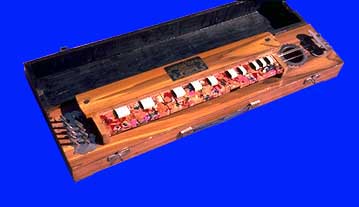
|
Bulbul tarang, also known as the "banjo", is a common instrument
in India. The name bulbul tarang literally translates to "waves of
nightingales". It is made of a number of strings passing over what
resembles a finger board. However, instead of directly fingering the
keys, they are pressed with a series of keys like a piano. Sometimes
the keys are similar to a piano keyboard, but more often they
resemble typewriter keys. The instrument is common for folk
musicians and children because of its very low price. strings passing over what
resembles a finger board. However, instead of directly fingering the
keys, they are pressed with a series of keys like a piano. Sometimes
the keys are similar to a piano keyboard, but more often they
resemble typewriter keys. The instrument is common for folk
musicians and children because of its very low price.The origin of the bulbul tarang is interesting. It is an Indian version of the Japanese taisho koto. The first taisho koto was built by Goro Morita in 1912 in Nogoya Japan. The term taisho refers to the second former Japanese emperor; while the term koto refers to it being a stringed instrument. The taisho koto became a very popular instrument in Japan; by 1929 it is estimated that over quarter of a million units were sold. Although it is established that the bulbul tarang is derived from the taisho koto, the obvious question is "what was the situation before that?" There is great reason to believe that the taisho koto is a technical extension of the various pianolins, pianettes, and hurdy gurdies, that were popular in the 19th century.
Tuning the bulbul tarang is very easy, however we must not forget
that there are innumerable variations in size, number of strings,
gauge of strings, etc. Therefore, we will just go over the general
principles and you can work out the details.
|
||